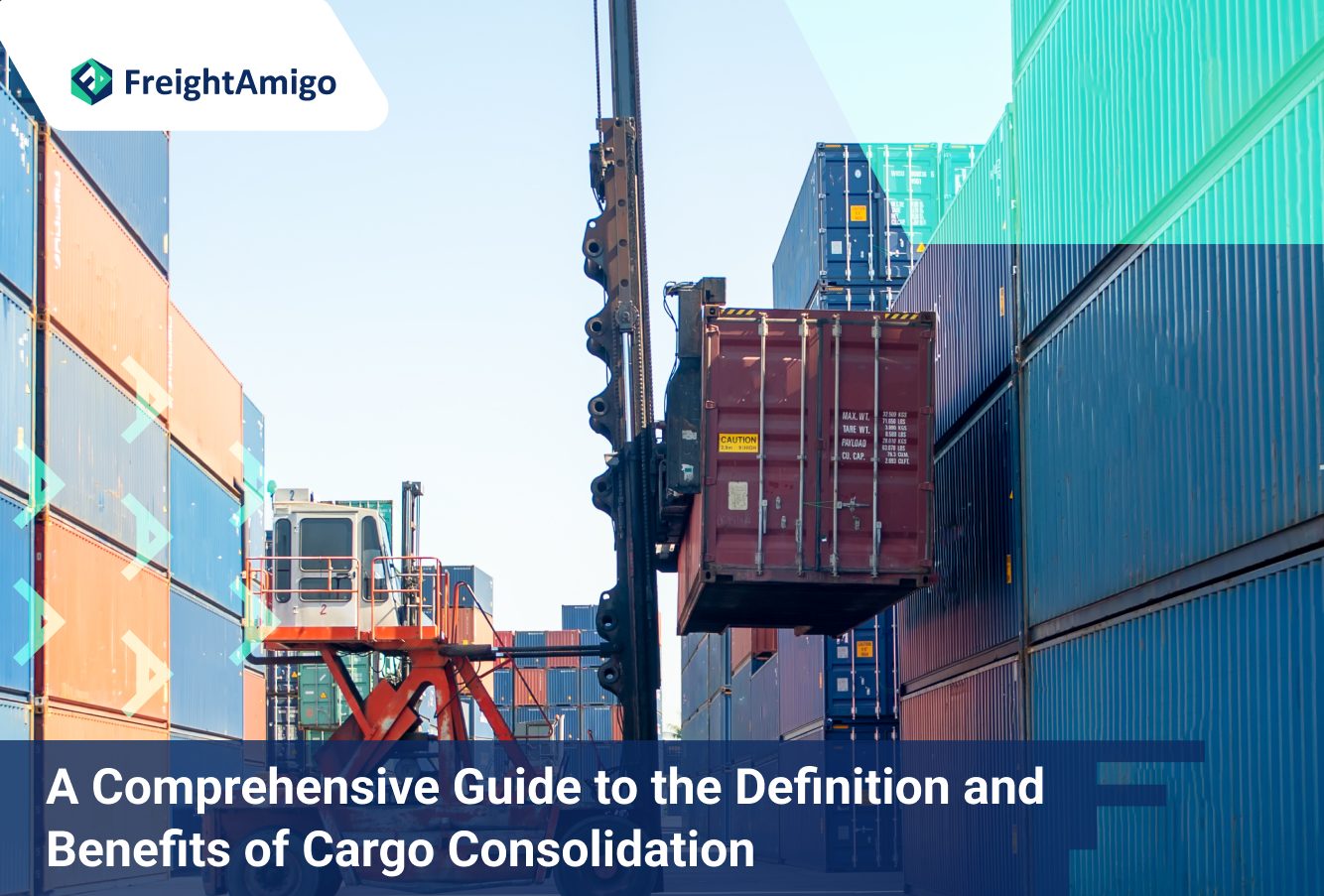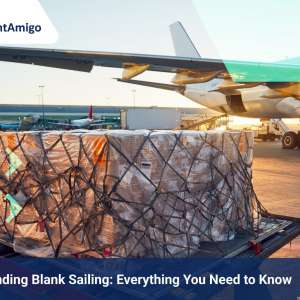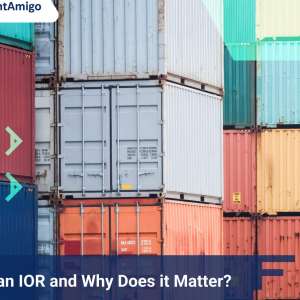A Comprehensive Guide to the Definition and Benefits of Cargo Consolidation
Latest update on 25 March, 2024 by Aiden Ng– Marketing Analyst at FreightAmigo
Cargo consolidation is a strategic process that involves combining multiple shipments from different sources into a single shipment. This practice is widely used in the logistics industry to optimise transport efficiency and reduce costs. By consolidating freight, companies can maximise the use of available space in shipping containers, trucks or warehouses, while streamlining the overall supply chain process.
Freight consolidation is particularly beneficial for small and medium-sized businesses that may not have enough goods to fill an entire container or truckload. By sharing space with other companies, they can still access cost-effective transportation options and benefit from economies of scale. In addition, freight consolidation allows companies to reduce the number of shipments, which in turn minimises the carbon footprint associated with transportation. To ensure a smooth process during consolidation, FreightAmigo helps by providing more information on the benefits and process below.
Want to compare the best Express, Air Freight, Sea Freight, Rail Freight & Trucking rates so as to have better control on cost?
Benefits of freight consolidation
There are many benefits to implementing freight consolidation in your supply chain. Firstly, it enables cost savings. By combining shipments, companies can negotiate better rates with carriers due to the increased volume of goods being transported. This can result in significant cost reductions, especially for small businesses that may not have the same bargaining power as larger companies.
Freight consolidation also improves efficiency. Instead of managing multiple shipments individually, companies only need to coordinate a single consolidated shipment. This simplifies the logistics process, reduces paperwork and minimises the risk of errors or delays. In addition, by consolidating freight, companies can take advantage of direct shipping routes and optimise transport routes, resulting in faster delivery times and improved customer satisfaction.
Another key benefit is increased visibility and control over the supply chain. By consolidating freight, companies can more effectively track and monitor the movement of their goods. This enables better inventory management, improved resource allocation and increased visibility across the supply chain. With a clear view of the entire logistics process, companies can proactively identify and address any potential problems or bottlenecks.
The cargo consolidation process
The process of cargo consolidation involves several steps to ensure a smooth and efficient operation. The first step is to identify the cargo to be consolidated. This includes determining the volume, weight and type of goods to be consolidated. Companies should also consider any special handling requirements or restrictions that may apply to certain items.
Once the cargo has been identified, the next step is to select a reliable and experienced cargo consolidation service provider. This is a critical decision as the chosen provider will be responsible for coordinating the entire consolidation process. Companies should consider factors such as the provider’s reputation, track record, network of partners and ability to meet specific requirements.
Once a provider has been selected, freight is collected from various sources and transported to a consolidation point. Here the goods are carefully inspected, sorted and organised according to their destination. The consolidation point acts as a hub where multiple shipments are combined into one larger shipment. This process requires effective communication and coordination between the freight consolidation service provider and all parties involved.
Once the cargo has been consolidated, it is loaded onto a transport vehicle, such as a container or truck. The consolidated shipment is then transported to its final destination, which may be a distribution centre, warehouse or directly to the customer. Throughout the transportation process, the freight consolidation service provider ensures proper documentation, tracking and handling of the goods to maintain visibility and control.
Types of cargo consolidation
There are several types of freight consolidation methods that can be used depending on a company’s specific needs. The most common types are
- Less than Container Load (LCL) consolidation: This method is used when the volume of cargo does not fill an entire shipping container. The cargo is consolidated with other companies’ goods to maximise container space and reduce costs.
- Full Container Load (FCL) consolidation: This method fills a single container with goods from one company. This is suitable for companies with a large volume of cargo that can fill an entire container.
- Cross-docking consolidation: This method involves transferring goods from inbound vehicles directly to outbound vehicles without the need for warehousing or storage. It is a time-efficient approach that minimises handling and storage costs.
- Hub and spoke consolidation: This method uses a central hub to consolidate shipments from different sources, which are then transported to their respective destinations. It is commonly used in air freight and courier services.
Choosing the right type of consolidation method depends on factors such as cargo volume, transportation requirements, budget constraints and delivery times.
Factors to consider when selecting a cargo consolidation service provider
When selecting a freight consolidation service provider, there are several factors that companies should consider to ensure a successful partnership:
- Experience and expertise: Look for a provider with a proven track record in cargo consolidation. Experience in handling similar types of cargo and familiarity with specific industry requirements are key.
- Network and partnerships: A reliable provider should have a strong network of partners, including carriers, warehouses and distribution centres. This ensures seamless coordination and efficient transportation.
- Technology and transparency: Choose a provider that uses advanced technology systems to track and monitor cargo. Real-time visibility allows for better control and proactive decision making.
- Customisation and flexibility: Every company has unique needs and preferences. Your chosen provider should be able to tailor its services to meet specific needs and adapt to changing circumstances.
- Service quality and reliability: Look for a provider with a reputation for delivering quality service and consistently meeting deadlines. References and customer testimonials can provide valuable insight into their reliability.
Cargo consolidation challenges and solutions
While there are many benefits to cargo consolidation, there are also challenges that companies may face during the process. Some common challenges include
Communication and coordination
Coordinating multiple shipments from different sources requires effective communication and coordination. Miscommunication or delays in information exchange can result in shipment errors or delays. To overcome this challenge, companies should establish clear communication channels and use technology platforms that facilitate real-time information sharing.
Cargo compatibility
Consolidating cargo from different sources may involve different types of goods with specific handling requirements. Ensuring compatibility and preventing damage or contamination can be challenging. Thorough inspection and sorting processes, as well as proper packaging, can help mitigate this risk.
Documentation and compliance
Consolidating cargo often involves dealing with various documentation requirements and compliance regulations. Ensuring that all the necessary paperwork is in order and complies with international trade regulations can be complex. Working with an experienced cargo consolidation service provider can help overcome these challenges and ensure compliance.
Risk management
Cargo consolidation increases the risk of loss, theft or damage in transit. Adequate insurance coverage and the implementation of proactive risk management strategies, such as proper packaging and tracking systems, can minimise these risks.
How to implement freight consolidation in your supply chain
Implementing freight consolidation in your supply chain can be a strategic decision that requires careful planning and execution. Here are some steps to consider:
- Assess your needs: Evaluate your current supply chain and identify areas where freight consolidation can bring the most benefit. Consider factors such as transportation costs, delivery times, inventory management and overall efficiency.
- Research and select a provider: Conduct thorough research to identify reputable freight consolidation service providers. Request quotes, review their capabilities and assess their compatibility with your specific requirements.
- Establish communication channels: Establish clear communication channels and protocols with the selected provider. Ensure you have a dedicated point of contact who can provide regular updates and address any concerns.
- Integrate technology: Leverage technology platforms that enable real-time tracking and monitoring of your consolidated shipments. This will provide visibility and control over the entire supply chain process.
- Monitor and evaluate: Regularly monitor the performance of your freight consolidation process. Evaluate key performance indicators such as cost savings, delivery times and customer satisfaction. Make adjustments as necessary to optimise benefits.
Conclusion: Is cargo consolidation right for your business?
Cargo consolidation is a powerful strategy that can bring many benefits to companies of all sizes. By combining shipments, companies can achieve cost savings, improve efficiency and gain greater control over their supply chain. However, successful implementation requires careful planning, selecting the right service provider and overcoming potential challenges. By following the steps outlined in this article, companies can harness the power of freight consolidation and optimise their logistics operations. If you’re considering consolidation for your business, FreightAmigo can help ensure a smooth and successful process.
If you are considering cargo consolidation for your business, it is best to have the full support of logistics experts! To find out more about cargo consolidation, please visit the FreightAmigo enquiry page.
If you have any inquiries on logistics/supply chain, feel free to contact FreightAmigo now:
Chat with us online | Hotline: +852 28121686 | WhatsApp: +852 27467829









































